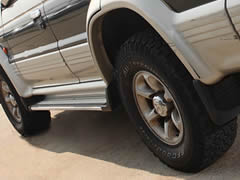Different Types of Wheel Drives - Vol.151
There are mainly four different types of wheel drives that form the unique features of automobile engineering. These four types include front wheel drive (FF), rear wheel drive (RR), rear mid – drive (MR) and four wheel drive (4WD). Each of these wheel drives has unique specialties and driving features that are best suited to specific surfaces and weather conditions. Some are well adapted to slippery and bumpy roads while others perform best in mountainous areas with heavy snow and rainfall. Moreover, every drive follows an independent operational mechanism that is best suitable for both the vehicle and driver.

In a FF or front wheel drive the IC engine along with the driven wheels are paced on the front side of the vehicle. Previously most of the classic car versions like Ford Focus and ST' 06 embedded this type of wheel drive technology. An important feature of front wheel drive is the reduction of central tunnel and its higher chassis requirement. These characteristics make the front wheel drive cars superior to the one's driven with rear wheel drive. Presently the FF layout is rarely being used in high performance cars. This is due to the fact that under high acceleration most of the weight is transferred to the rear wheels and there is a danger that the front wheels may lose their grip on the road.
RR or the rear wheel drive follows an exactly opposite fashion as compared to the FF drive layout. Both IC engine and the driving wheels are placed on the rear side of the vehicle. This type of layout provides some added advantages when the vehicle is being used for hill climbing in low traction conditions. Since this layout allows high speed braking and accelerations it is employed in most of the vehicles like Volkswagen New Beetle 2.0 etc. where high performance is required. However, there are some disadvantages associated with RR drive. Placing the engine on the rear side increases the net weight on the rear axle of the vehicle which gives creates a technical problem; weight bias. This means that the stability of the car is compromised and it tends to over steer especially in the decelerating conditions.
Next on the list is the MR or rear mid - engine layout that represents a hybrid technology compromising the disadvantages of both the FF and RR wheel drive technologies. With a little modification of engine placement the MR wheel drive is being used among the highest speed vehicles around today. MR wheel drive is similar to RR with only the engine placed in front of the rear wheels. This type of design enhances the dynamic weight performance of the vehicle and improves the road grip. Most of the sports cars including the ones used in Formula One racing embed this technology. The only disadvantage associated MR wheel drive is the lack of cargo space and high maintenance cost.
Another hybrid type of wheel drive is the FR or front engine and rear wheel drive. This type of layout helps to increase drivers control on the vehicle. The chassis is situated a little higher to allow a shaft to transfer power from the engine to the rear wheel shaft. Most of the modern and classic cars embed the FR wheel driven technology. With FR the steering mechanism becomes quite simple and soft to handle. Cars like Mazda RX-7 and HONDA S2000' 01 have FR wheel drive technology in them.
The last type of wheel drives is the 4WD, or the four wheel drive, that includes a powertrain allowing all four wheels of a vehicle to receive torque. This technology allows the driver to lock down front and rear drive shafts in conditions when some extra torque is required. However, both the driven shafts spin at the same speed. The only disadvantage associated with this technology is that it can result in shaft binding in case of swift turns. Added improvements in this technology involve embedding state of the art anti slip technology that makes every wheel spin at a different speeds. This technology boosts up the power and torque requirements of a vehicle since all the four wheels share their task.